The safe way forward at ComfortDelGro Driving Centre
15 Mar 2019|10,110 views
Driving seems to be easy. Go through all the theory and practical tests, score well, and you get a chance to be in the driver's seat. But over time, we tend to lose the lessons we learnt that have helped keep us away from clocking dreaded demerit points during our driving test.
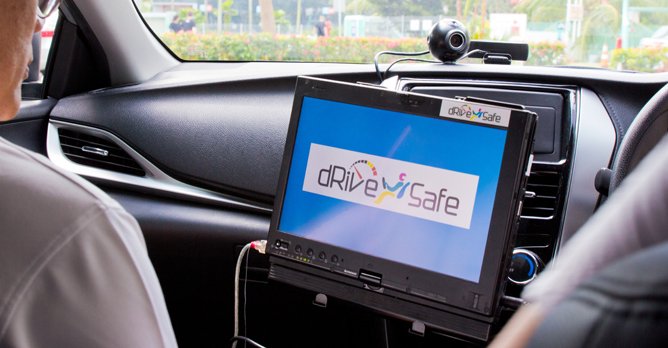
These small mistakes we make can contribute to accidents, big or small. Hence, ComfortDelGro Driving Centre (CDC) wants to help prevent these accidents from happening with its Drive Safe Course. A CDC initiative, this course aims to correct behaviours behind the wheel that drivers may have unknowingly developed over the years, resulting in accidents.
Not to be mistaken for the Safe Driving Course organised by the Traffic Police for those who have clocked demerit points, the Drive Safe Course welcomes drivers who would like a refresher on what good driving habits are.
Getting the theory right
Back when us drivers were getting licenced, we learnt it all. Safe following distances and give way rules were some things we memorised by hard, but when quizzed during the course, even this writer had some doubts on the right answer.
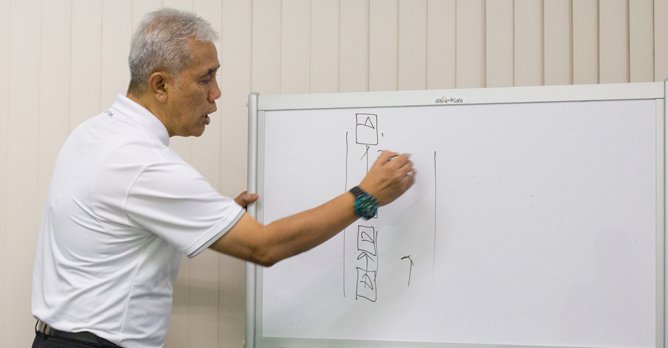
Immediately, we felt it was our right of way, and we would naturally horn to make our presence known. But the simple fact is that doing so doesn't immediately offset the possibility of an accident. The simple act of slowing down and maintaining a safe distance can alleviate any possibility of an accident happening.
We learnt a number of new things, too. We all know that putting on your seatbelt is vital as it prevents occupants from being thrown about in an accident. But Mr. Yusoff also mentioned that not belting up would also mean that the airbags would not be activated in an event of a car crash, as it is meant to work in conjunction with seatbelts.
Continuing on with examples of accidents that can be easily avoided, we then moved towards the interesting part of the course - getting behind the wheel.
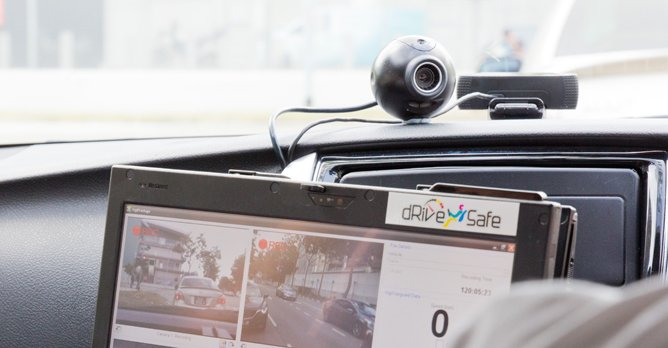
What is different compared to the regular driving lessons is now you have multiple cameras watching your every move - from your hand positions to eye movement, along with sensors recording everything from throttle to braking, speed and G-force meters to measure 'comfort' levels - or how smooth your driving is.
These systems are part of CDC's Driver Development Tool, which uses the said plethora of tech to calculate how good your driving is.
We drove normally on the road with directions from our instructor, before turning back to CDC to access our results.
Some tips on keeping your car running right
Once we were done with both our theory and practical lessons, our instructor shared with us some tips on how we should keep our cars in check. According to him, driver behaviour might be the cause of accidents, but not having your car running right can worsen, or even cause accidents themselves.
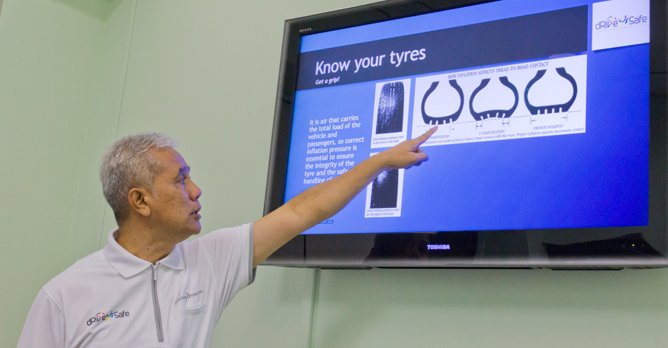
Replacing tyres might be a simple affair, but Mr. Yusoff called for fresh tyres to be used, sharing with us on how to check on the tyre's date of manufacture to ensure that sweet deal you got for tyres isn't old stocks.
And on to the results of this writer…
At the end of the course, the results were shared amongst the participants. I was awarded a 'low risk' driver rating in regards to how prone I was to accidents on the road. I'm certainly happy that my driving hasn't at all been deemed dangerous, but 'low risk' doesn’t mean no risk. Mr. Yusoff then pulled out a full telemetric review of my driving.
Although I didn't manage to get the sensors of the Driver Development Tool ringing in terms of how uncomfortable the ride was, I was marked down (and caught on camera) for not scanning the environment enough. It is best to always check your rear-view mirror ever so often, to anticipate any incidents that may happen from the rear.
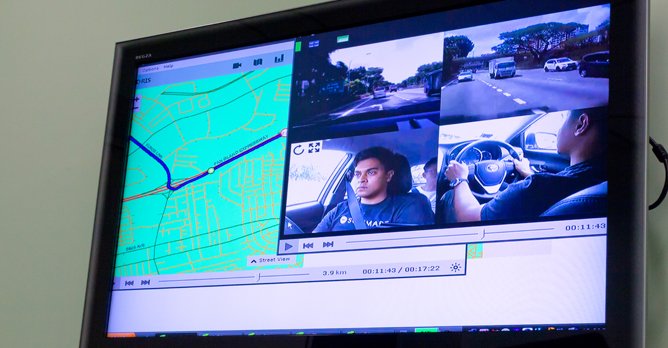
Another point where I was marked down upon was the position of my hands on the steering wheel, which I subconsciously placed one hand at the 12 o'clock position.
Although relaxing, this reduces my ability to react quickly to situations on the road. Plus, my arms would have been impacted by the airbag if it were to deploy, causing more injuries than necessary.
At the end of the course, it is a nice reminder that we all are not invincible behind the wheel, and we should always adopt simple routines to keep our driving safe for us and others on the road.
Driving seems to be easy. Go through all the theory and practical tests, score well, and you get a chance to be in the driver's seat. But over time, we tend to lose the lessons we learnt that have helped keep us away from clocking dreaded demerit points during our driving test.

These small mistakes we make can contribute to accidents, big or small. Hence, ComfortDelGro Driving Centre (CDC) wants to help prevent these accidents from happening with its Drive Safe Course. A CDC initiative, this course aims to correct behaviours behind the wheel that drivers may have unknowingly developed over the years, resulting in accidents.
Not to be mistaken for the Safe Driving Course organised by the Traffic Police for those who have clocked demerit points, the Drive Safe Course welcomes drivers who would like a refresher on what good driving habits are.
Getting the theory right
Back when us drivers were getting licenced, we learnt it all. Safe following distances and give way rules were some things we memorised by hard, but when quizzed during the course, even this writer had some doubts on the right answer.

Immediately, we felt it was our right of way, and we would naturally horn to make our presence known. But the simple fact is that doing so doesn't immediately offset the possibility of an accident. The simple act of slowing down and maintaining a safe distance can alleviate any possibility of an accident happening.
We learnt a number of new things, too. We all know that putting on your seatbelt is vital as it prevents occupants from being thrown about in an accident. But Mr. Yusoff also mentioned that not belting up would also mean that the airbags would not be activated in an event of a car crash, as it is meant to work in conjunction with seatbelts.
Continuing on with examples of accidents that can be easily avoided, we then moved towards the interesting part of the course - getting behind the wheel.

So you think you're a good driver?
What is different compared to the regular driving lessons is now you have multiple cameras watching your every move - from your hand positions to eye movement, along with sensors recording everything from throttle to braking, speed and G-force meters to measure 'comfort' levels - or how smooth your driving is.
These systems are part of CDC's Driver Development Tool, which uses the said plethora of tech to calculate how good your driving is.
We drove normally on the road with directions from our instructor, before turning back to CDC to access our results.
Some tips on keeping your car running right
Once we were done with both our theory and practical lessons, our instructor shared with us some tips on how we should keep our cars in check. According to him, driver behaviour might be the cause of accidents, but not having your car running right can worsen, or even cause accidents themselves.

Replacing tyres might be a simple affair, but Mr. Yusoff called for fresh tyres to be used, sharing with us on how to check on the tyre's date of manufacture to ensure that sweet deal you got for tyres isn't old stocks.
And on to the results of this writer…
At the end of the course, the results were shared amongst the participants. I was awarded a 'low risk' driver rating in regards to how prone I was to accidents on the road. I'm certainly happy that my driving hasn't at all been deemed dangerous, but 'low risk' doesn’t mean no risk. Mr. Yusoff then pulled out a full telemetric review of my driving.
Although I didn't manage to get the sensors of the Driver Development Tool ringing in terms of how uncomfortable the ride was, I was marked down (and caught on camera) for not scanning the environment enough. It is best to always check your rear-view mirror ever so often, to anticipate any incidents that may happen from the rear.

Another point where I was marked down upon was the position of my hands on the steering wheel, which I subconsciously placed one hand at the 12 o'clock position.
Although relaxing, this reduces my ability to react quickly to situations on the road. Plus, my arms would have been impacted by the airbag if it were to deploy, causing more injuries than necessary.
At the end of the course, it is a nice reminder that we all are not invincible behind the wheel, and we should always adopt simple routines to keep our driving safe for us and others on the road.
Thank You For Your Subscription.
































